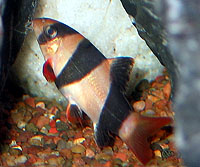Cobitidae: Difference between revisions
sv iw fix |
GrahamBould (talk | contribs) m Case |
||
| Line 53: | Line 53: | ||
===Loaches often encountered in aquarium trade=== |
===Loaches often encountered in aquarium trade=== |
||
* [[Horseface |
* [[Horseface loach]] — ''Acantopsis choirorhynchus'' |
||
* [[Longnose |
* [[Longnose loach|Longnose Loach]] — ''Acantopsis octoactinotos'' |
||
* [[Weather loach| Weather or Dojo loach]] — ''Misgurnus anguillicaudatus'' (although ''Misgurnus fossilis'' and ''Cobitis taenia'' are also referred to as weather loaches). |
* [[Weather loach| Weather or Dojo loach]] — ''Misgurnus anguillicaudatus'' (although ''Misgurnus fossilis'' and ''Cobitis taenia'' are also referred to as weather loaches). |
||
* [[Kuhli |
* [[Kuhli loach]] — ''Pangio kuhlii'' |
||
* [[Clown |
* [[Clown loach]] — ''Chromobotia macracanthus'' |
||
* [[Yoyo |
* [[Yoyo loach|Yoyo or Pakistani loach]] — ''Botia almorhae'' |
||
==Cultural Note== |
==Cultural Note== |
||
| Line 64: | Line 64: | ||
"Why, they will allow us ne'er a jordan, and then we leak in your chimney; and your chamber-lie breeds fleas like a loach." (Act 2) |
"Why, they will allow us ne'er a jordan, and then we leak in your chimney; and your chamber-lie breeds fleas like a loach." (Act 2) |
||
In the video game, "[[The Legend of Zelda: Ocarina of Time]]" on the Nintendo 64, the largest fish you can catch is the Hylian |
In the video game, "[[The Legend of Zelda: Ocarina of Time]]" on the Nintendo 64, the largest fish you can catch is the Hylian loach. |
||
== External links == |
== External links == |
||
Revision as of 14:47, 4 October 2006
| Loaches | |
|---|---|

| |
| Scientific classification | |
| Kingdom: | |
| Phylum: | |
| Class: | |
| Order: | |
| Family: | Cobitidae
|
| Genera | |
|
Acanthopsoides | |
Loaches are freshwater fish of the family Cobitidae, small benthic (bottom-dwelling) fish with a flattened ventral profile. There are 160 different species of them. Loaches are mostly scavengers and are omnivorous, usually not very picky about their food. They may eat aquatic crustaceans, insects and other small invertebrates as well as scraps of organic detritus. Many live in waters of generally poor quality and feed on tubifex worms which are associated with those areas. Some have adapted to less-than-ideal water conditions by being able to gulp up atmospheric oxygen from the air. Loach species are distributed through Europe, Asia, and in Morocco. They mainly inhabit rapid-moving streams.
Because of their scavenging nature and their ability to adapt to many freshwater ecosystems, some loaches have been introduced to waters in regions which they are not native to and may pose problems to local wildlife as an invasive species.
Typical Features
The body forms of various loaches range from being vermiform (worm-shaped; long and thin) to Fusiform (spindle-shaped; cylindrical and tapering toward the ends). Most loaches do not have true scales. Like catfishes, loaches have the sensory organs known as barbels; usually 3-6 pairs of them. Some other characteristics of loaches are a small bottom-facing mouth suited to their scavenging benthic lifestyle, an erectile spine below the eye, and a single row of pharyngeal (throat) teeth.
Economic Importance
Some loach species are popular as food fish in East Asian countries such as Japan. They are of importance in the fisheries or being raised in aquaculture. Some species of loach may occasionally be caught for bait.
Many of the more brightly-colored loach species are popular with freshwater aquarists and are therefore of importance in the aquarium trade. The more colorful tropical loaches that are kept as pets mainly come from South Asia and South-East Asia.
Loaches often encountered in aquarium trade
- Horseface loach — Acantopsis choirorhynchus
- Longnose Loach — Acantopsis octoactinotos
- Weather or Dojo loach — Misgurnus anguillicaudatus (although Misgurnus fossilis and Cobitis taenia are also referred to as weather loaches).
- Kuhli loach — Pangio kuhlii
- Clown loach — Chromobotia macracanthus
- Yoyo or Pakistani loach — Botia almorhae
Cultural Note
Referenced by Shakespeare in Henry IV, part 1: "Why, they will allow us ne'er a jordan, and then we leak in your chimney; and your chamber-lie breeds fleas like a loach." (Act 2)
In the video game, "The Legend of Zelda: Ocarina of Time" on the Nintendo 64, the largest fish you can catch is the Hylian loach.
